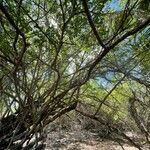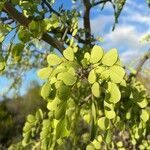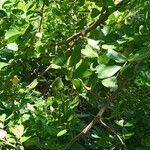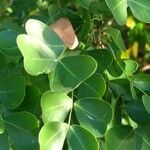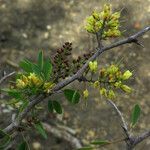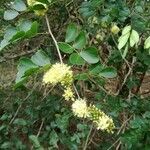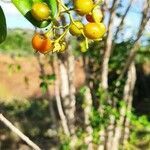Trees, small, to 8 m tall, sometimes with spreading branches and shrubby. Trunk deeply sulcate. Bark light gray. Branchlets slender. Leaves 5-10 cm, shortly petiolate; leaflets 2-4 pairs, abaxially pale green, adaxially shiny, obovate to obcordate, 1-3 cm, papery, with fine veins, base cuneate, apex rounded or deeply emarginate. Racemes 2-5 cm, with several to numerous flowers; peduncles short. Pedicels 4-6 mm, slender. Calyx 3-4 mm; lobes oblong-lanceolate, apex acute. Petals yellow, narrowly obovate, 5-6 mm, apex obtuse. Stamens ca. as long as petals. Legume lanceolate-oblong, 2-5 × 0.8-1.2 cm; valves thin, with fine veins.
Tree up to c. 15 m high. Leaves with one spine in the axil, 3-5-jugate, petiole with rachis up to c. 10 cm. Leaflets subsessile, opposite, obovate, 2-3 by 1-2.5 cm, emarginate or subtruncate at apex, cuneate at base, glabrous; nerves and veins fine. Inflorescences up to 6(-12) cm long, rather densely flowered; pedicels 4-6 mm. Flowers fragrant. Calyx lobes yellow or purple-tinged, ovate, 3-4 mm long. Petals bright yellow, obovate, 5-6 mm. Stamens almost the same length as petals. Ovary and style pubescent. Pods 2-6 by 0.8-1.2 cm.
A large shrub or small tree. It grows 10 m tall. The leaves are 3-8 cm long and have 4 pairs of leaflets. These are 1-3 cm long and broadly oval. The flowers are 1.2 cm across. They are yellow. The fruit is a pod about 4 cm long and 8-10 mm wide. It is narrowed at both ends. There are 2-3 seeds.
A smallish tree.. With closely veined obovate-emarginate or subtruncate leaflets (sometimes the lowest pair replaced by a pair of 1–2-jugate pinnae).. Flowers rather small, yellow, in axillary racemes.. Pods rather small, flattened and elliptic-oblong, opening down the middle of the valves.
